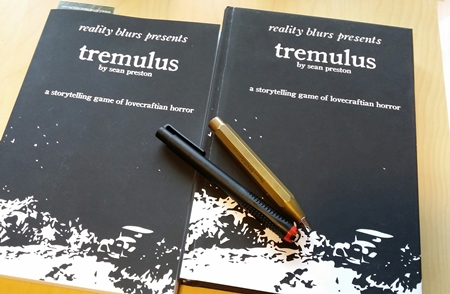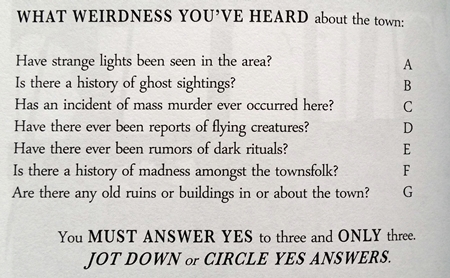I wrapped up a second campaign of tremulus (paid link), a Powered by the Apocalypse RPG of Lovecraftian horror by Sean Preston, this past Tuesday night. I’ve been meaning to write about tremulus for some time, because it’s a great game, it’s underrated, and I initially underrated it myself.

It’s basically “Call of Cthulhu (paid link) by way of Apocalypse World,” which sounded like chocolate meets peanut butter to me when it popped up on Kickstarter back in 2012. After 19 sessions across two campaigns (one playing, one GMing), I’m ready to talk about it here on Yore.
First impression
My initial impression wasn’t favorable.
One of the things I love about being an avid RPGGeek[1] user is that when I want to know what I thought about a game four years ago, it’s easy to find out. Here’s what I said about it after one session:
“I’ve played one session of tremulus, character creation plus an hour or so of play that was purely introductory. I can’t shake the sense that this isn’t a great implementation of Apocalypse World, but I’ll give it a more thorough shakedown as the campaign progresses.”
Not exactly a ringing endorsement! My initial rating was a 7 out of 10, which was giving it the benefit of the doubt.
(Quoting myself seems insufferably pretentious, but I want to show how my thinking on tremulus changed over time, and it’s the easiest and most direct way to do that.)
Second impression
I stuck to my guns and gave it more thought as that campaign progressed, and things changed:
“Several sessions in, I’m enjoying the game largely despite the system. It’s just not a particularly deft or interesting AW hack. There are some good bits, to be sure, but not as many as I’d like. The playbooks are mostly pretty boring and same-y, and I’d likely be having just as much fun with the same good group and a different system.
I enjoy PbtA games enough to like the core of what I’m getting here despite the fact that it’s surrounded with a fair amount of blah. The non-blah, for me, remains the Ebon Eaves playset aspect — that’s quite cool.”
When I wrote that, I revised my rating downwards from a 7 to a 6.
It kept gnawing at me
But I couldn’t get that campaign out of my head, and it started to become clear to me that there was more there than I’d thought.
“Months later, looking back on one of my favorite campaigns, I see that I’m conflicted about this game. Humdrum rules, but it’s fun to play. Do I wish the rules were more interesting? Yep. But Call of Cthulhu by way of Apocalypse World is pretty awesome.”
New rating: 8.
Running tremulus
My online group enjoyed our first campaign, and I was itching to run an extended PbtA game, so we circled back to it with me in the GM’s chair. This showed me a whole different side of the game.
“Yeah, there’s more in here that I love — the framework/thread/hazard tech is EXCELLENT. Doesn’t take long to pull together, dovetails beautifully with the playsets, and balances inspiration with prescriptive elements beautifully.
There are a lot more playbooks now, too, including many more with interesting features/rules — which were lacking in the core rules. The “tremulus ecosystem” has expanded into something very cool.
I love the “structured takeoff” provided by a playset + framework + playbooks. Lots of guidance, but no railroading or plotting things out. I see how the rules connect with that now, too, and overall I like the game a lot.”
New rating: 9 out of 10. I’ve played 104 different RPGs as of this writing, and I rate 19 of them a 9 (and zero of them a 10).[2]
For me, this is a good example of how hard it is to assess an RPG without playing it. Which, you know, duh — but short of buying every book you ever see, you have to assess games you haven’t played.
My initial assessment of tremulus might have kept me from playing it, and I’d have missed out on a great game.
What I love about tremulus
The main thing I love is how it plays. I don’t do session prep, and when I GM I love sitting down at every session just like I was a player: not knowing what’s going to happen, and not having done any work between sessions. tremulus is fantastic for that.
It also delivers on what it promises: Lovecraftian horror with the trappings you expect from Call of Cthulhu, but all of the player agency, surprises, and not-plotting-things-out-in-advance you expect from a PbtA game.
tremulus also makes the clever choice to leave the amount of Lovecraft in your game up to you. By default, it assumes your group will be creating its own entities, cults, mysteries, and other setting elements in a Lovecraftian vein, rather than using deep ones, Yog-Sothoth, and all the rest. But if you’d prefer to play “straight CoC,” it supports that option as well.
The fourth biggie is the tremulus ecosystem (paid link). If you got into the game now, you’d have access to a wealth of playbooks, playsets, and other content that didn’t exist back when I first picked up the core book. The supplemental playbooks in particular are more interesting than the initial ones.
My group has played two playsets: Ebon Eaves, the peculiar town featured in the core book, and Frozen Wasteland (paid link), which is in the vein of At the Mountains of Madness (paid link). Both are excellent, and playsets are a huge part of what I love about tremulus.
Before you start in-character play, the players choose three options from the “What you think to be real” list and three from the “What weirdness you’ve heard” list about Ebon Eaves (or about whatever playset you’re using). Here’s the second list:

Those six choices (three from each list) produce two letter codes, like “ACG” or “BDE,” and those codes all have brief write-ups in the book. Every combination is unique, and quite different — two groups playing a tremulus game set in Ebon Eaves won’t play the same game unless they choose the exact same codes.
As a player, this approach produced the seeds of a town with several mysteries that were all spooky and creepy and interesting to poke at. As a GM, it gave me more than enough to chew on when setting up the game — which ties into another thing I love about tremulus.
To create the default setup (e.g., Ebon Eaves, an antarctic expedition), you prep only the questions that pop out at you — the starting point for the mysteries and weirdness, but no further. For example, in our Frozen Wastes game, one question was “Why is Professor Crawford so desperate to rediscover Hyperborea?” I didn’t know the answer until, through actual play, my players’ choices combined with my improvisation produced one.
All of that combines to facilitate Lovecraftian horror so well that as much as I love Call of Cthulhu, I’m pretty sure I’d reach for tremulus first.
Ia! Ia! tremulus fhtagn!
tremulus (paid link) is a superb game.
It’s underrated, and it doesn’t get the attention I think it deserves. If “Call of Cthulhu + Apocalypse World” sounds appealing, I suspect you’ll like it.
[1] AKA the most useful RPG tool you’re not using.
[2] It’s also one of an even smaller number of games of which I own multiple copies. It’s got enough moving parts that I found it helpful to have two books on hand when running it.

This is super interesting to me. If you at all have any interest in cyberpunk – I would love for you to skim the veil and give me your thoughts. The first draft and playbooks are free. Any insights, I feel, would be really helpful.
I want to play Tremulus so badly now!
I almost backed that one, but hesitated because it sounded like it might surprise me by requiring more prep than I want to do.
Here’s the thread where the designer weighed in on that: https://rpggeek.com/thread/1567369/kickstarter-veil-rpg-designed-tell-compelling-chal
The playbooks looked neat, and I like the spin it’s putting on the genre. Whereas Sprawl is more “PbtA Shadowrun,” Veil looks different.